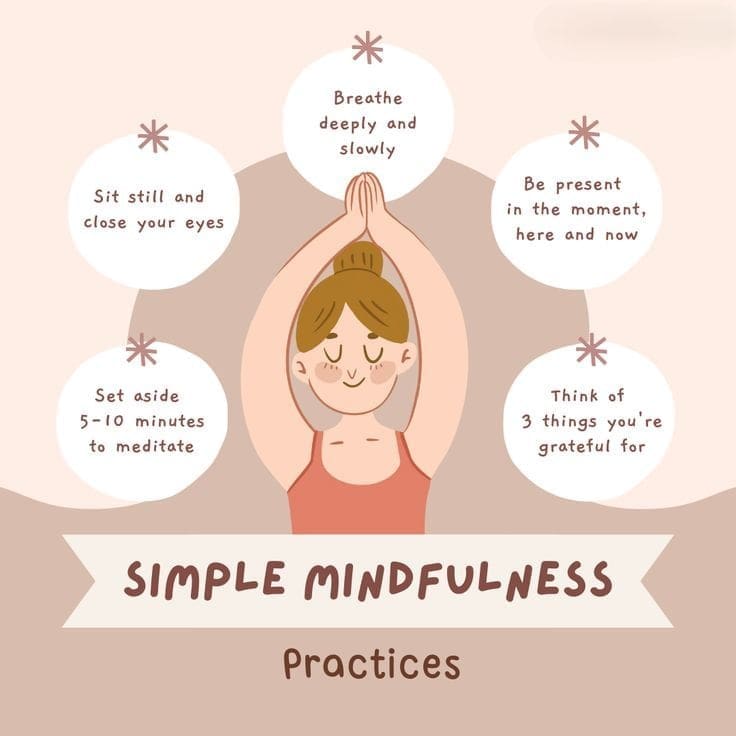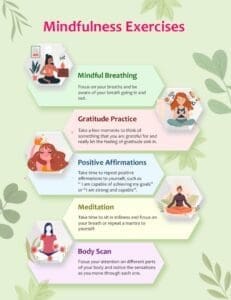Have you ever found yourself overwhelmed by stress or anxiety and wished for a simple way to regain your calm? Mindful breathing exercises might just be the answer you’re looking for. These techniques can help you center your thoughts, reduce anxiety, and cultivate a sense of peace in your life. Practicing mindful breathing exercises regularly creates a foundation of calm that you can return to in any situation.
What Is Mindful Breathing?
Mindful breathing is a practice that involves paying attention to your breath and being fully present in the moment. This technique encourages you to observe your breathing patterns without judgment, helping to bring a sense of awareness to your mind and body. The act of focusing on your breath can be a powerful anchor, allowing you to cultivate mindfulness and create space for relaxation.
The Science Behind Mindful Breathing
Research shows that mindful breathing can influence your physical and mental well-being. When you’re mindful of your breathing, it can help lower cortisol levels—your body’s primary stress hormone. Additionally, mindful breathing activates the parasympathetic nervous system, which is responsible for the body’s relaxation response. This is why incorporating such exercises into your daily routine can enhance your overall quality of life.
Benefits of Mindful Breathing Exercises
You might wonder why you should take the time to practice mindful breathing. Here are some compelling benefits:
Reduces Stress and Anxiety
One of the most significant benefits of mindful breathing exercises is their ability to reduce stress and anxiety. When you focus on your breath, your mind has less space to spiral into anxious thoughts. The act of breathing deeply also signals your body to relax.
Enhances Focus and Concentration
Mindful breathing helps sharpen your focus and improve your concentration. By regularly practicing this technique, you train your mind to remain present and attentive, making it easier to engage in tasks and activities.
Improves Emotional Regulation
Mindful breathing encourages emotional awareness, allowing you to recognize and manage your feelings more effectively. With practice, you can learn to respond to emotional triggers with greater calmness rather than reacting impulsively.
Promotes Physical Health
Engaging in mindful breathing can enhance your physical health as well. It can lower blood pressure, improve lung capacity, and even aid digestion. By incorporating breathing exercises into your routine, you’re taking proactive steps toward better health.
Aids in Sleep
Struggling with insomnia or restless nights? Mindful breathing exercises can serve as a gentle lullaby for your mind. Practicing before bed can calm racing thoughts and promote relaxation, making it easier for you to fall asleep. Many people find that mindful breathing exercises before bed help signal the body that it’s time to rest.
Simple Mindful Breathing Exercises to Try
Now, let’s get practical! Here are some simple yet effective mindful breathing exercises you can incorporate into your daily routine. Feel free to practice these in a quiet space where you can focus and feel comfortable.
Deep Breathing
Deep breathing is perhaps the simplest form of mindful breathing. It helps you tap into your body’s natural relaxation response.
- Find a Comfortable Position: Sit or lie down in a comfortable position.
- Inhale Deeply: Take a deep breath in through your nose, allowing your abdomen to expand.
- Hold Your Breath: Hold your breath for a count of four.
- Exhale Slowly: Slowly release your breath through your mouth for a count of six.
- Repeat: Continue this cycle for five to ten minutes.
Tip: Make sure to focus solely on your breath. If your mind starts to wander, gently bring your focus back to your breathing.
Box Breathing
Box breathing is a technique often used by those in high-stress environments, including military personnel. It’s a structured exercise that helps you create a rhythm with your breath.
- Inhale for Four Counts: Breathe in deeply through your nose for a count of four.
- Hold for Four Counts: Hold your breath for another count of four.
- Exhale for Four Counts: Slowly breathe out through your mouth for a count of four.
- Hold Again for Four Counts: Hold your breath once more for a count of four.
- Repeat: Continue this cycle for several minutes.
| Count | Action |
|---|---|
| 4 | Inhale |
| 4 | Hold |
| 4 | Exhale |
| 4 | Hold |
4-7-8 Breathing
The 4-7-8 technique is a simple yet powerful breathing exercise designed to promote relaxation and support better sleep.
- Exhale Completely: Start by exhaling fully through your mouth to clear your lungs.
- Inhale for Four Counts: Close your mouth and inhale quietly through your nose for a count of four.
- Hold for Seven Counts: Hold your breath for a count of seven.
- Exhale for Eight Counts: Finally, exhale completely through your mouth for a count of eight.
- Repeat: Repeat this cycle a total of four times.
| Count (Inhale) | Count (Hold) | Count (Exhale) |
|---|---|---|
| 4 | 7 | 8 |
Alternate Nostril Breathing
This technique, known as Nadi Shodhana in yoga, helps balance the body’s energies and calm the mind.
- Sit Comfortably: Sit in a comfortable position with your spine straight.
- Close Right Nostril: Use your right thumb to close your right nostril.
- Inhale Through Left Nostril: Inhale deeply through your left nostril.
- Close Left Nostril: Close your left nostril with your right ring finger.
- Exhale Through Right Nostril: Release your thumb from your right nostril and exhale through it.
- Inhale Through Right Nostril: Inhale through the right nostril.
- Switch: Close the right nostril and exhale through the left nostril.
- Continue: Continue this pattern for several minutes.
Mindful Breathing with Visualization
Combining mindfulness and visualization can enhance the experience and deepen your relaxation.
- Sit Comfortably: Find a comfortable seated position.
- Close Your Eyes: Gently close your eyes and take a few initial deep breaths.
- Visualize a Calm Place: Imagine a peaceful environment, such as a beach or a forest.
- Breathe with the Visualization: As you breathe in, imagine inhaling the peace of this place, and as you breathe out, release any tension or stress you feel.
- Continue: Spend about ten minutes in this practice, maintaining focus on your breath and your visualization.
Quick Mindful Breathing Exercise
Sometimes you only have a minute or two to spare. Here’s a super quick technique:
- Inhale for Five Counts: Breathe in deeply through your nose for five counts.
- Exhale for Five Counts: Release your breath through your mouth for five counts.
- Repeat: Do this for about one minute, focusing only on your breath.
Incorporating Mindful Breathing into Daily Life
Mindful breathing doesn’t have to be a standalone practice. You can incorporate it seamlessly into your daily life. Here are some ideas:
Morning Routine
Start your day by dedicating a few minutes to mindful breathing. Before you even get out of bed, take a moment to focus on your breath and set positive intentions for your day.
During Breaks
Whether you’re at work or home, taking short breaks to practice mindful breathing can reset your mind and body. A few minutes of focused breathing can help you tackle your tasks with renewed energy.
Before Sleep
Incorporating mindful breathing into your nighttime routine can help you wind down and promote better sleep. Aim for a calming breathing exercise just before bed.
While Commuting
If you use public transportation, try practicing mindful breathing to ease any tension. Even in a busy environment, you can focus on your breath and create a sense of calm.
Tips for Successful Mindful Breathing Practice
As you embark on your mindful breathing journey, here are some friendly tips to enhance your practice. Over time, these small choices will help you build a lasting relationship with mindful breathing exercises.
Find a Quiet Atmosphere
Although mindful breathing can be practiced anywhere, finding a quiet space free from distractions can significantly enhance your experience. You deserve that serenity!
Be Patient with Yourself
It’s natural for your mind to wander during these exercises. When it happens, simply acknowledge it and gently bring your focus back to your breath without judgment.
Set a Routine
Incorporating mindful breathing into your daily routine can yield more significant benefits over time. Consider setting aside specific times for practice, just like any other important activity.
Keep it Comfortable
Ensure you’re comfortable during practice. Sit or lie in a position that feels good for you. Your body should be relaxed to allow for deep, mindful breaths.
Use Guided Practices
If you’re new to mindful breathing, guided meditations or apps can be incredibly helpful. Listening to someone guide you through the process can offer both structure and support.
Common Obstacles to Mindful Breathing and How to Overcome Them
Practice can sometimes come with challenges. Here are some common obstacles and solutions to help you navigate them:
Distractions
Distractions can make it challenging to maintain focus. Consider choosing a time and environment with fewer potential interruptions, or use techniques such as counting your breaths to redirect your attention when your mind wanders.
Impatience
Feeling impatient or frustrated with your practice is common. Remind yourself that mindfulness is a journey that takes time and consistency. Celebrate small victories instead of expecting perfection.
Physical Discomfort
Physical discomfort can interfere with your practice. Try different positions or props, such as cushions, to help you feel more at ease.
Lack of Time
If you feel pressed for time, remember that even a couple of minutes can be beneficial. Shorter sessions can still deliver significant results.
Moving Forward: Make Mindful Breathing a Lifelong Habit
Growing your mindfulness practice takes time, but with patience and dedication, it can become a natural part of your daily life. Prioritize your well-being and take small, consistent steps toward incorporating mindful breathing exercises into your routine.
Reflect on Your Progress
Keep a journal to track your progress. Noting how you feel before and after each session can help you recognize the positive impacts of your practice and inspire continued commitment.
Connect with Others
Sharing your experiences with friends or family can enhance your motivation and accountability. Consider practicing together or discussing your experiences to gain insights and encouragement.
Continue Learning
There’s always more to learn about mindful breathing and mindfulness in general. Explore books, workshops, and online courses to deepen your understanding and technique.
Conclusion
Mindful breathing exercises are a powerful tool that can help you navigate the stresses of daily life with greater ease and peace. You have the ability to cultivate mindfulness wherever you are, and with consistent practice, these techniques can transform your mental and emotional well-being. So why not take a few moments today to focus on your breath? Your mind and body will thank you for it. By choosing to practice mindful breathing exercises, you’re investing in long-term emotional balance, clarity, and self-awareness.
Disclaimer
The content is purely informative and educational in nature and should not be construed as medical advice. Please use the content only in consultation with an appropriate certified medical or healthcare professional


